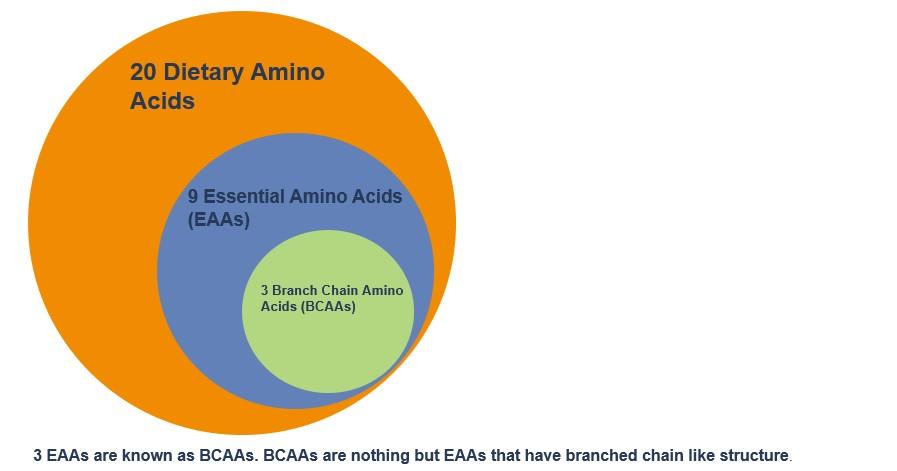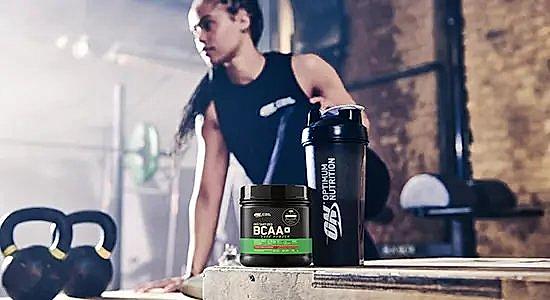 |||
5 minutes
|||
5 minutes
History of BCAAs usage for performance.
In the past, branched chain-amino acids (BCAAs) were predominantly used by powerlifters and the bodybuilding community. However, BCAAs are becoming progressively adopted across the wider athletic population. Today, many performance-driven and fitness-focused individuals are turning to BCAAs for support. BCAAs can help those involved in prolonged intense activity and those looking to support muscle. Those who may consider supplementing with BCAAs to support muscle recovery include endurance athletes, team sports athletes, physique athletes, strength athletes, elite athletes, and extreme exercise enthusiasts. Let’s take a closer look at BCAAs.
The difference between BCAAs and EAAs
There are twenty-two amino acids, nine of which are considered essential or indispensable, thus known as Essential Amino Acids (EAAs). Amino acids are the building blocks of protein. Essential amino acids cannot be made by the body, therefore must be obtained through dietary sources. Furthermore, each amino acid has a distinct molecular structure and functions differently. Some attract water while some repel water. Some have a positive charge while others a negative charge. The BCAAs are a specific set of essential amino acids, which make up a little more than one third of skeletal muscle. They have a branched chain-like structure and include three essential amino acids - leucine, isoleucine and valine.

BCAA Vs EAA, which is better?
Now we know that all BCAAs are EAAs.
Below is a list of the Essential Amino Acids (EAAs):
Histidine
Leucine
Isoleucine
Valine
Lysine
Methionine
Phenylalanine
Threonine
Tryptophan
Technically all amino acids, be essential or non-essential are important and needed for muscle protein synthesis and many other functions in the body. BCAAs however have few more added benefits.
BCAAS HELP SUPPORT MUSCLE RECOVERY
BCAAs are key building blocks to help support muscle recovery after exercise and may help spare the muscle during prolonged exercise.
BCAAS HELP SUPPORT MUSCLE PROTEIN SYNTHESIS
Physical activity can activate mammalian target of rapamycin (mTOR) pathways, which signals that the muscles need to recover and rebuild. Leucine, in particular, helps to ‘switch on’ muscle protein synthesis by signaling and regulating mTOR pathways. Over time, resistance training combined with proper rest and nutrition can lead to muscle growth – otherwise known as hypertrophy.
BCAAS CAN SERVE AS A FUEL SOURCE FOR WORKING MUSCLES
BCAAs have the potential to act as a fuel source for exercising muscle and other tissues. BCAAs can be used as fuel during prolonged activities and endurance activities like cycling and running.
To wrap up the question on the hand, BCAAs Vs EAAs which one is better? We know that BCAA are a type of EAA and all essential amino acids are important for muscle recovery, however BCAAs can act as an intra-workout muscle support and also trigger Muscle Protein Synthesis (MPS) so BCAAs win here by a slight margin. And now that you know BCAAs are important let us discuss them is a bit more detail.
BCAAS FOODS SOURCES
BCAAs can be found in a variety of foods in varying amounts. In fact, animal-based protein sources naturally contain BCAAs such as eggs, fish, turkey, beef, chicken, wild game and dairy products like yogurt, cheese, and milk. Milk contains two types of proteins, casein, and whey. Both naturally contain BCAAs as well. There are approximately 5.5 grams of naturally occurring BCAAs in about 24 gram of whey. Plant-based sources may also contain BCAAs, but often in lower amounts compared to animal sources. Soy products such as tempeh, edamame, and tofu are considered complete protein sources and contains all the essential amino acids in sufficient quantities – including BCAAs. You can also build a complete protein with adequate amounts of BCAAs by pairing complementary incomplete protein sources, such as rice and beans or peanut butter and wheat toast.
WHY DO I SEE THE 2:1:1 RATIO OF BCAAS IN SUPPLEMENTS?
A 2:1:1 ratio of BCAAs refers to the ratio of leucine, to isoleucine and valine. Therefore, supplementing with ≥5 grams BCAAs in a 2:1:1 ratio, equates to 2.5 grams of leucine, 1.25 grams of isoleucine and 1.25 grams of valine. This is roughly the naturally occurring ratio found within a typical glass of milk. It’s also roughly the same ratio found in skeletal muscle. Moreover, supplements that are derived from dairy products will also have naturally-occurring BCAAs. For example, whey and casein are the protein constituents derived from milk, therefore both will contain naturally-occurring BCAAs.
BCAA WRAP UP
BCAAs are essential amino acids, which include: leucine, isoleucine, and valine. Active individuals may decide to incorporate BCAAs in a variety of ways. BCAAs can help to support muscle recovery, spare muscle during prolonged exercise, and support muscle protein synthesis, or as a fuel source for exercising muscle. BCAAs can be obtained through certain foods by selecting a variety of complete protein sources such as eggs, poultry, beef, milk, yogurt, cheese, soy, etc. Casein and whey are milk based proteins and in turn have naturally-occurring BCAAs. You may also stack products with BCAA specific products.
